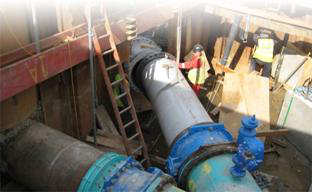Olympic
Park Utilities Networks |
|
Whole Project with Interim Award
Project Team
Client: Olympic
Delivery Authority
Design: Atkins
Construction: McNicholas
The Project
The remit of the Utilities Network packages was to divert and/or remove existing utilities together with the provision of both new and temporary utilities. The objective of the works was to create aresilient, long lasting infrastructure network that would not require significant extension or augmentation for 30 years. All of the new networks were developed as an integrated solution to meet both the requirements for the Olympic Park as well as the Stratford City development, which will include certain provisions for the Games (such as the Olympic Village).
Requirements at Legacy phase were therefore also considered. With the gas networks, for example, the design philosophy was to provide a suitable and robust gas infrastructure which met the requirements of both the Olympic phase and the Legacy phase, whilst maintaining the design philosophy of ‘green, mean and lean’.
As part of the Park wide application of CEEQUAL, the Utilities works were assessed in three CEEQUAL Assessments:
- District heating and cooling network;
- Telecommunications network;
- Potable water, gas, and electrical networks.
Park-wide utilities network
The CEEQUAL Assessment described here, covers; the design component of the new potable water network, the intermediate and low pressure gas networks, and the electrical network.
These networks comprised:
- 100km of electrical ducting;
- 4.2km of intermediate pressure (IP) gas main;
- 1.5km of low pressure (LP) gas main;
- 8km of potable water piping; and
- Supporting substations and tie-ins to appropriate off-site networks.
The nature of the Utilities water, gas and electrical work packages as primarily below ground, with networks located in service corridors provided by the preceding Enabling Works project, meant that a significant proportion of the questions were scoped out of the CEEQUAL Assessment at the start of the process. The scoped out questions included those relating to the assessment and treatment of contaminated land, flood risk assessment, and the ecological and heritage survey questions. These were addressed by the Enabling Works project.
The CEEQUAL Assessment of the Utilities water, gas and electrical work packages achieved an ‘Excellent’ rated score of 87.7%, well above the CEEQUAL ‘Excellent’ threshold of 75%.
The key aspects of the project that led to this high score were:
Integrated project team – both within the Utilities work packages, and also with the other Olympic Park infrastructure projects (particularly the Enabling Works and the Structures, Bridges and Highways (SBH) projects):
- Work with the Enabling Works team meant that double handling of soils and fill material was avoided in the construction of service corridors.
- Work with the SBH team provided bridges with integrated pipetracks.
A selection of materials were used to maximise the use of recycled materials and to reduce the embodied energy:
- The steel pipe used had a 60% recycled content, and the plastic pipe 66%;
- Overall 54% of materials used (excluding fill materials) were recycled materials;
- 541 Tonnes of CO2 was saved by replacing PVC with high density polyethylene for the electrical ducting, the telecoms and non-potable water pipes.
Design to minimise material use, embodied energy and wastage:
- With the water network a non-inset pipe design was proposed that would reduce material requirement by 50% with a concomitant reduction in the potential for leakage.
- Trenching was designed so that full lengths of pipe could be laid without having to cut pipe on-site into shorter lengths - thereby reducing the potential for wastage of materials at construction, and water leakage in operation.

Potable water infrastructure

Utilities infrastructure
Material selection and design were considered to minimise land take. As well as reducing the need to excavate (and remediate) any more soil materials than necessary, this approach also allowed for more trees and existing vegetation to be retained. Minimal land take was achieved through:
- Designing for minimum pipe diameters for the gas main networks; and
- Minimising the number of above ground electricity sub-stations required.
Materials sourcing to reduce road transport impacts:
- 53% of all materials for the Utilities networks brought onto site by rail.
Key benefits and success factors
- An ‘Excellent’ rated (87.7%) project, well above the CEEQUAL ‘Excellent’ threshold of 75%, and denoting the project team as one that is committed to going the ‘extra mile’ to improve environmental performance where possible.
- Opportunities taken through the use of CEEQUAL, minimised the environmental impact of the project through a design and materials selection strategy that minimised land take, material consumption and waste generation.

